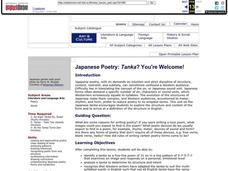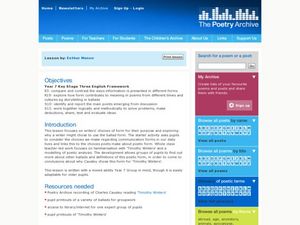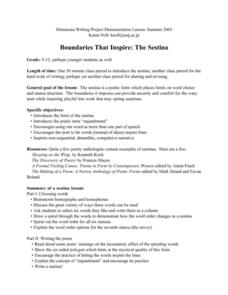Curated OER
Pride and Prejudice: Biopoem
Describe yourself or a character from Jane Austen's Pride and Prejudice with a biopoem activity. Using the provided format, kids write their own characteristics or the character traits from the novel to create a poetic portrait.
Curated OER
Discourse
Explore the different types of discourse and language with your lecture students in this presentation, which explores "sweet language," "stuffy language," and "poetic language," among others. Helpful for English, Sociology, Semantics, or...
Curated OER
You Kiss By the Book
Students explore Shakespeare's use of poetic conventions, examine the first meeting between Romeo and Juliet and gain experience in close readng and the interpretation of verse structure and imagery.
Curated OER
Shakespeare's Romeo and Juliet: 'You Kiss by the Book'
High schoolers explore Shakespeare's Romeo and Juliet. In this analysis lesson, students recognize the use of poetic conventions as a principle of dramatic structure after analyzing the sonnetShakespeare created for the first meeting...
Curated OER
Working with Shakespeare, the Poet and Dramatist
Students study the work of William Shakespeare. They survey the elements of comedy and tragedy and read plays and poems. They discuss the texts they read and recite poetry. They dramatize poems with movement and sounds and write poetry...
Curated OER
Haiku: An Introduction to Writing and Discussing Poetic Form
Tenth graders are introduced to the vocabulary that is acceptable and unacceptable in writing a haiku. Individually, they are given a set of instructions in which to write their haiku and discuss how these limitations have affected...
Hong Kong Special Administrative Region
Learning English through Poems and Songs
Exposing learners to the power of words in poetry is a stimulating way to learn languages. Songs, haikus, rhyming words, and narrative works are all employed in a resource for teaching English as a Second Language.
Santa Ana Unified School District
Early American Poets
The poems of Walt Whitman and Emily Dickinson are the focus of a unit that asks readers to consider how an artist's life and changes in society influences his or her work. After careful study of Whitman's and Dickinson's perspectives on...
Education Closet
West Side Shifts
Combine math, language arts, music, and dance with an activity focused on "America" from West Side Story. After listening to the song, learners compare the film to Romeo and Juliet, analyze the song's meter, design choreography, plan...
Curated OER
A Elegy
Students examine an elegy for form, tone and subject matter. In this elegy activity, students share impressions from Dylan Thomas's poem and a critic's response to the poem. Students discuss emotions and the refusal to mourn...
Curated OER
Narrow Road to the Interior
Students investigate the life and work of the Japanese poet, Matsuo Basho as the Japanese poetic forms are studied. Nature, symbolism, and history are probed as the lesson is developed.
Curated OER
Poetry Prodigies
Young scholars in three classes in different locations become Poetry Prodigies as they use iChat AV and an iSight camera to teach and explore from each other about different poetic styles. They explore six types of poetry are taught:...
Curated OER
Japanese Poetry: Tanka? You're Welcome!
Students explore the structure and content of the Tanka form and to arrive at a definition of the structure in English. They analyze a tanka to determine its structure and intent and compose two Tanka; one in traditional form and one...
Curated OER
Edward Lear, Limericks, and Nonsense: There Once Was...
Learners recognize poetic devices including rhyme, syllabification, and meter. They identify the characteristics of a nonsense poem and of a limerick. They write their own limericks.
Curated OER
Ballads and Communication
Students compare and contrast different forms of communication. In this poetry lesson, students focus on the ballad form and read "Timothy Winters". Students draw conclusions from the ballad and divide into groups to research the...
Curated OER
Show Don't Tell
Students review the Show Don't Tell method of writing haiku poetry. They practice distinguishing poetic language from academic language and create poems based on images, not explanations.
Curated OER
The Tabloid Ballad
Learners explore the poetic ballad. They examine the rhythm of a typical ballad and listen to recitations of sample ballads. They choose an article from a supermarket tabloid and write a comical ballad using rhythms and structures...
Curated OER
Writing Poems Worksheet
In this writing poems worksheet, students record 10 nouns, then write 2 or 3 verbs next to each noun, and finally write a simile or metaphor that matches the noun and verbs in that row. Students then organize these lines into stanzas to...
Curated OER
Modernism in Poetry, Painting, and Music
Are you teaching Modernism to your class? Connect different areas of artistic expression in the Modernist Era. Learners read T.S. Eliot, view art by Pablo Picasso, and listen to a Modernist musical composition. This final assignment is...
Curated OER
Boundaries That Inspire: The Sestina
Students study the poetic term "enjambment". They use one word as more than one part of speech and let words (instead of ideas) inspire lines and non-sequential, dreamlike, compulsive narrative.
Curated OER
Japanese Tanka
Young scholars compare and contrast the two forms of poetry. They are concerned with practicing the styles of both in order to reproduce their own creative work. Research is done to look for the backgrounds of both styles and how they...
Curated OER
Korean Sijo
Students investigate the concept of Sijo as a form of poetry. They compare it to other forms of poetry in the interest of pointing out unique characteristics of Sijo. They use the research information in order to compose their own Sijp...
Curated OER
ESL Poetry Unit
Students complete a twelve activity unit on poetry. They read and respond to different forms of poetry, write a bio poem, complete an online WebQuest, and in small groups present lessons to the class on various types of poems.
Curated OER
Juvenile Delinquency
Ninth graders analyze and interpret historical research by examining, analyzing, and forming opinions regarding primary resources. They compare/contrast social conflict, its causes and effects, in regards to continuity and change over time.























